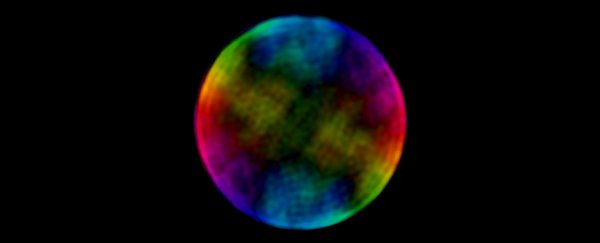Blue Moon. Strawberry Moon. Supermoon. Snow Moon. Blood Moon. Earth's favourite satellite buddy has a name for every occasion. Yet the most glorious view of the full Moon we've seen to date has no name.
That's probably because it's not indicative of an occasion, but a way of looking at our satellite. With your naked eyes, you would never see the rainbowy, soap-bubble-like view of the Moon as pictured above.
But that's what it looks like to the Australian Square Kilometre Array Pathfinder (ASKAP), an incredibly powerful radio telescope array located in the desert of Western Australia.
We can't, of course, see radio waves with our eyes anyway. But even just looking at radio waves emitted from the Moon would show a very different image.
That's because the Moon is inefficient at reflecting light; it only reflects about 6 percent of the radio waves that reach it. Most of the radio waves are absorbed and re-emitted as black-body radiation, corresponding to the Moon's temperature.
The image of the Moon below, for example, was taken by the National Radio Astronomy Observatory's 140ft Telescope in Green Bank, West Virginia. The Sun was to the left of the Moon at the time, which is why that side is emitting hotter radiation.
 (NRAO)
(NRAO)
What ASKAP is doing differently is detecting the polarisation, or orientation, of reflected radio waves. When radio waves bounce off a surface, they change orientation. The angle of polarisation will depend on the angle of the surface the radio waves are bouncing off, with respect to the viewer.
Since the Moon is a sphere, the angle of polarisation changes across the entire visible surface.
As senior research scientist Emil Lenc of CSIRO Australia explained, "The overall effect is that the orientation of the polarisation will always point towards the centre of the Moon, with the intensity being greatest at the limb." (The lunar limb is the outer visible edge of the Moon).
"Since colour was used to represent the orientation of the polarisation in the image above, we see this as a rainbow effect along the lunar limb, with opposite sides of the Moon having the same colour.
"Since the effect is strongest at the limb this gives an overall 'soap bubble' effect."
Our Moon is such a gorgeous thing, even when it's not trying.
